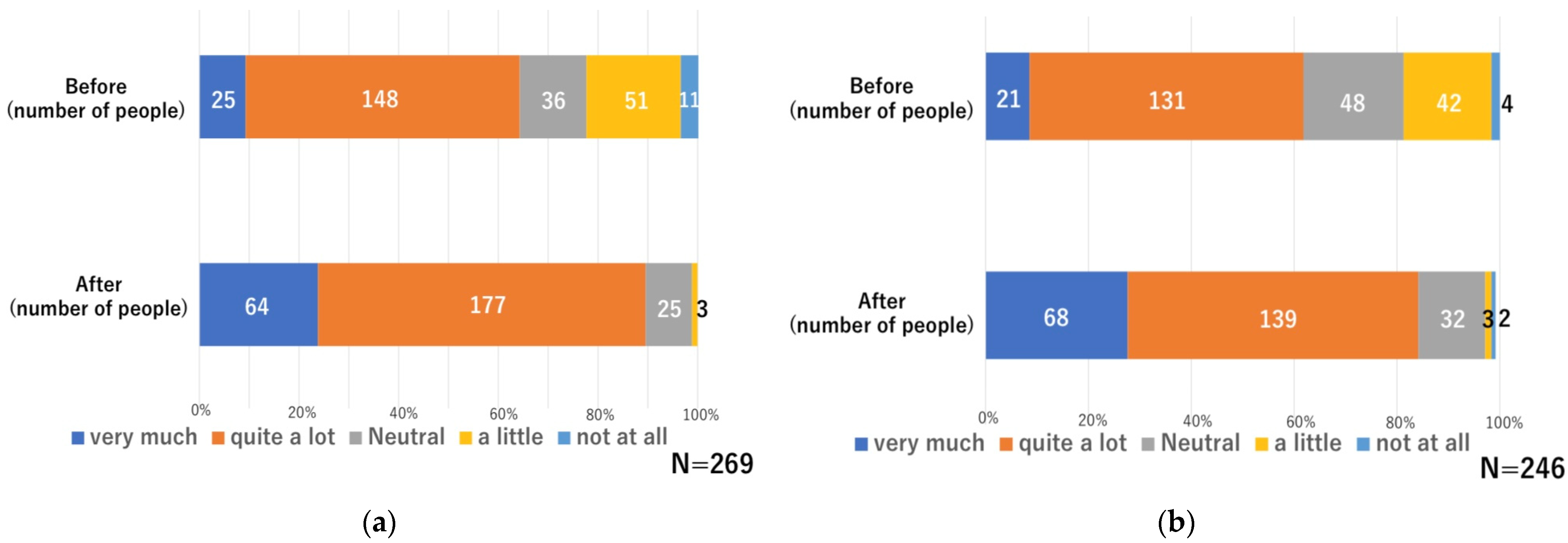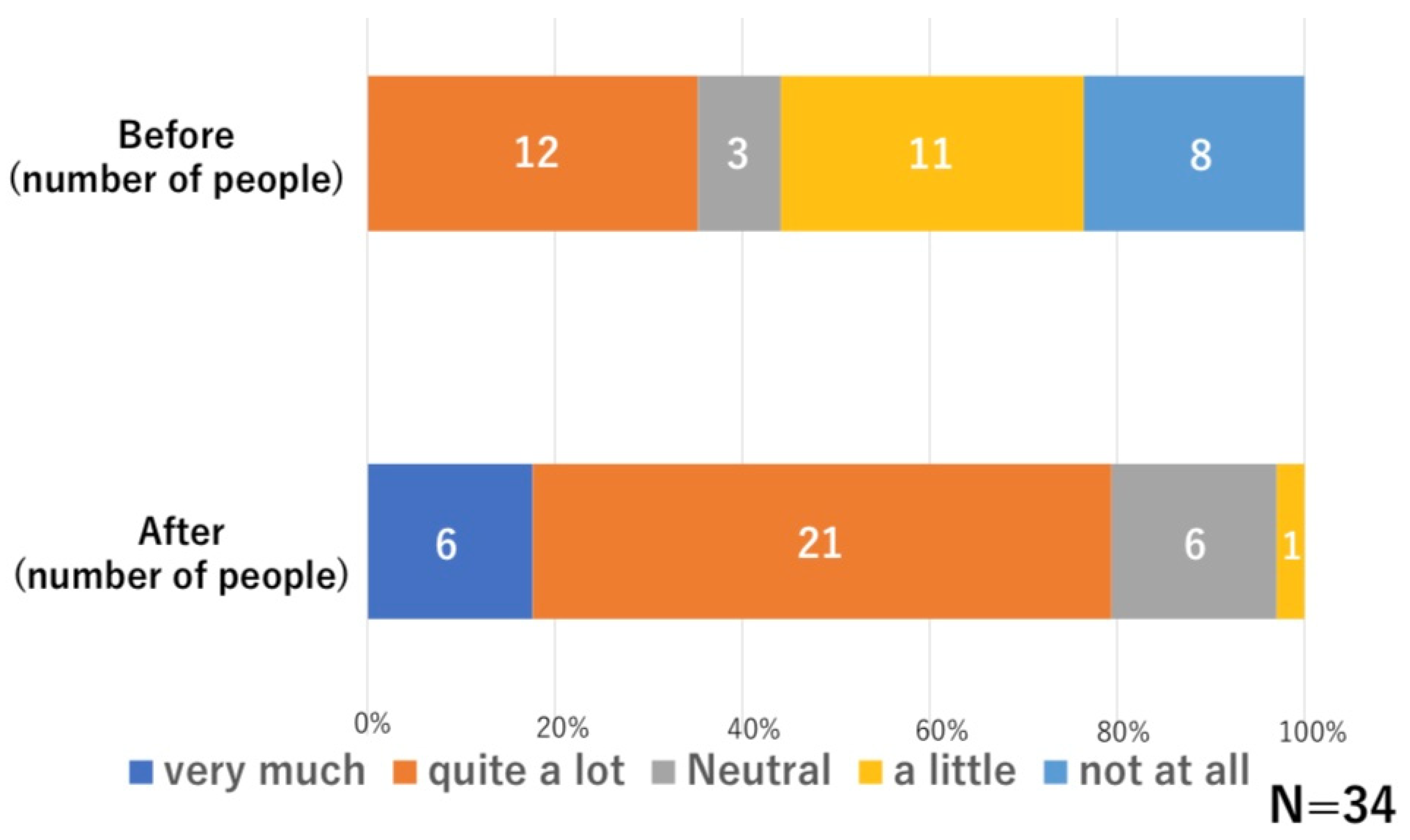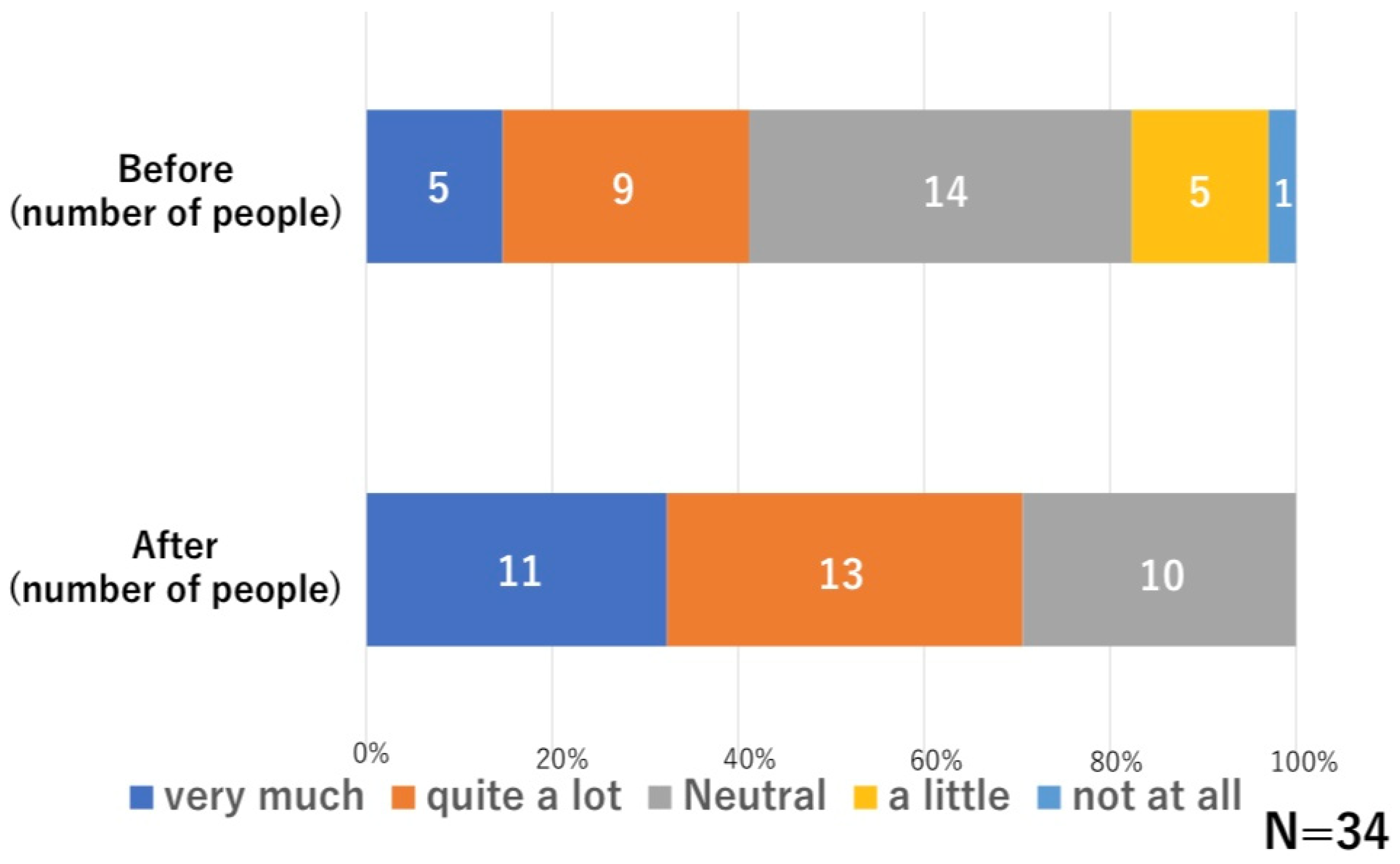Teaching the Effectiveness of Integrated Studies and Social Engagement: A Case Study on SDG Education in Depopulated Areas in Japan
Abstract
1. Introduction
1.1. Background of This Research
“ESD comprises learning and educational activities that aim to develop alternative values and transformative actions that lead to problem-solving and to realize a sustainable society by taking the initiative to accept these problems of modern society as our own and tackling the problems in our immediate environment (think globally, act locally) in order to ensure that human beings are able to secure an abundant life for future generations”.[3]
1.2. Literature Review
1.3. Sustainability of Regions as Seen from Regional Characteristics Based on Net Population Growth Rate in Japan
1.4. SDG Education in Tohoku Region
2. Materials and Methods
3. Results
4. Discussion
5. Conclusions and Future Tasks
Author Contributions
Funding
Institutional Review Board Statement
Informed Consent Statement
Data Availability Statement
Acknowledgments
Conflicts of Interest
References
- UNDP. The Sdgs in Action. Available online: https://www.undp.org/sustainable-development-goals (accessed on 19 December 2022).
- Rieckmann, M. Education for Sustainable Development Goals: Learning Objectives; UNESCO: Paris, France, 2017; Available online: https://books.google.co.jp/books?hl=ja&lr=lang_ja|lang_en&id=Fkssu8DgAAQBAJ&oi=fnd&pg=PP4&dq=Education+for+sustainable+development+goals:+Learning+objectives&ots=ZNJApAbehf&sig=Ew_XE37VBF_cYgz1Vqjaw5vaeBw#v=onepage&q=Education%20for%20sustainable%20development%20goals%3A%20Learning%20objectives&f=false (accessed on 19 December 2022).
- Ministry of Education. Education for Sustainable Development. Available online: https://www.mext.go.jp/unesco/004/1339970.htm (accessed on 19 December 2022).
- National Institute of Population and Social Security Research. Population Projections of Japan by Region. Available online: https://www.ipss.go.jp/pp-shicyoson/j/shicyoson18/1kouhyo/gaiyo_s.pdf (accessed on 19 December 2022).
- Takahashi, K.; Kawanaka, H.; Tanaka, K.; Nishimura, K.; Tsuruoka, S. Manufacturing in Depopulated Areas and Rural Areas through Industry-Academia Collaboration and Creation of Regional Brand Products. Ind.-Acad. Collab. 2019, 15, 41–49. Available online: https://www.jstage.jst.go.jp/article/jjsip/15/1/15_1_41/_pdf/-char/ja (accessed on 19 December 2022).
- Ministry of Education, Minister’s Secretariat, International Affairs Division. FY2020 Budget Request, Summary of Major Matters. Available online: https://www.mext.go.jp/component/b_menu/other/__icsFiles/afieldfile/2019/08/29/1420671_04.pdf (accessed on 19 December 2022).
- García-González, E.; Jiménez-Fontana, R.; Azcárate, P. Education for Sustainability and the Sustainable Development Goals: Pre-Service Teachers’ Perceptions and Knowledge. Sustainability 2020, 12, 7741. [Google Scholar] [CrossRef]
- Puertas-Aguilar, M.-Á.; Álvarez-Otero, J.; de Lázaro-Torres, M.-L. The Challenge of Teacher Training in the 2030 Agenda Framework Using Geotechnologies. Educ. Sci. 2021, 11, 381. [Google Scholar] [CrossRef]
- Ministry of Internal Affairs and Communications of Japan. Basic School Survey. General Counter for Official Statistics. Available online: https://www.e-stat.go.jp/stat-search/files?page=1&toukei=00400001&tstat=000001011528 (accessed on 19 December 2022).
- Sajima, T. Current Status and Problems of “Environmental Education” in Elementary and Junior High Schools. New Geogr. 1980, 28, 1–8. Available online: https://www.jstage.jst.go.jp/article/newgeo1952/28/1/28_1_1/_pdf/-char/ja (accessed on 19 December 2022). [CrossRef]
- Sajima, T. Verification of the Role of the Teacher’s Reference Materials for Environmental Education. Environ. Educ. 2007, 17, 13–18. Available online: https://www.jstage.jst.go.jp/article/jsoee/17/2/17_2_2_13/_pdf/-char/ja (accessed on 19 December 2022). [CrossRef]
- Hiyane, A.; Shiomi, S. The Effects of the Environmental Workshop on the School Students; The Research Example of the General Course High School in Fukushima Prefecture. Environ. Educ. 2014, 24, 91–98. Available online: https://www.jstage.jst.go.jp/article/jsoee/24/1/24_1_91/_pdf/-char/ja (accessed on 19 December 2022). [CrossRef]
- Asaoka, Y. Environmental Education under Globalization and Education for Sustainable Development (ESD). Educ. Stud. 2005, 72, 530–543. Available online: https://www.jstage.jst.go.jp/article/kyoiku1932/72/4/72_4_530/_pdf/-char/ja (accessed on 19 December 2022).
- Benítez, F.F.; Paredes, M.E.R.; Collado-Ruano, J.; Terán, E.F.H.; Ibarra, G.D.L. Environmental Education Program in Ecuador: Theory, Practice, and Public Policies to Face Global Change in the Anthropocene. Ens. Avaliação Políticas Públicas Educ. 2019, 27, 859–880. Available online: https://www.scielo.br/j/ensaio/a/7KS6gWqBCgHLfSPBn9HsS6m/?lang=en&format=html (accessed on 19 December 2022). [CrossRef]
- Andreoni, V.; Vargas, V.R. Tracking the Interlinkages across SDGs: The Case of Hill Centered Education Network in Bogota, Colombia. Sustainability 2020, 12, 7924. [Google Scholar] [CrossRef]
- Darmawan, M.D.; Dagamac, N.H. Situation of Environmental Education in Senior High School Programs in Indonesia: Perspectives from the Teachers of Palembang. Interdiscip. J. Environ. Sci. Educ. 2021, 17, e2241. Available online: https://www.ijese.com/download/situation-of-environmental-education-in-senior-high-school-programs-in-indonesia-perspectives-from-9605.pdf (accessed on 19 December 2022).
- Ministry of the Environment. Current Status of Environmental Issues and Trends in Laws and Regulations in Indonesia. Available online: https://www.env.go.jp/earth/coop/oemjc/ind/j/contents.html (accessed on 19 December 2022).
- Boyd, D.; Hirst, N.; Siraj-Blatchford, J. Understanding Sustainability in Early Childhood Education; Case Studies and Approaches from Across the UK, 1st ed.; Taylor & Francis: Abingdon, UK, 2017; Available online: https://www.routledge.com/Understanding-Sustainability-in-Early-Childhood-Education-Case-Studies/Boyd-Hirst-Siraj-Blatchford/p/book/9781138188297 (accessed on 19 December 2022).
- Borg, F. Sustainability in Preschool Educational Activities: A Case Study of an Eco-Certified Preschool in Sweden; Australian Association for Research in Education: Victoria, BC, Canada, 2018; Available online: https://www.diva-portal.org/smash/record.jsf?pid=diva2%3A1274748&dswid=4649 (accessed on 19 December 2022).
- Goodwin, S.; Brogaard, S.; Krause, T. Connecting Socio-Ecological Values and Education on Sustainable Development: A Case Study with Swedish Primary School Students; Lund University Publications: Lund, Sweden, 2020; Available online: https://lup.lub.lu.se/search/publication/e29f3ac7-8bc4-4490-b5e1-883a0344e6b7 (accessed on 19 December 2022).
- Borg, F.; Gericke, N. Local and Global Aspects: Teaching Social Sustainability in Swedish Preschools. Sustainability 2021, 13, 3838. [Google Scholar] [CrossRef]
- Kaj, R. Swedish Environmental Policy, Education and Ecotourism Issues. Available online: https://www.mgu.ac.jp/main/educations/library/publication/pre_hattatsu/no12/hatsurin12_14.pdf (accessed on 19 December 2022).
- Skolverket. Curriculum for Secondary Education in Sweden. Available online: https://www.skolverket.se/undervisning/gymnasieskolan/laroplan-program-och-amnen-i-gymnasieskolan/gymnasieprogrammen/program?url=1530314731%2Fsyllabuscw%2Fjsp%2Fprogram.htm%3FprogramCode%3DNB001%26tos%3Dgy&sv.url=12.5dfee44715d35a5cdfa9295 (accessed on 19 December 2022).
- Fredriksson, U.; Kusanagi, K.N.; Gougoulakis, P.; Matsuda, Y.; Kitamura, Y. A Comparative Study of Curriculums for Education for Sustainable Development (ESD) in Sweden and Japan. Sustainability 2020, 12, 1123. [Google Scholar] [CrossRef]
- Noh, J.E. The legitimacy of Development Nongovernmental Organizations as Global Citizenship Education Providers in Korea. Educ. Citizsh. Soc. Justice 2019, 14, 241–259. Available online: https://journals.sagepub.com/doi/abs/10.1177/1746197918799972 (accessed on 19 December 2022). [CrossRef]
- Cho, H.S. The Gaps between Values and Practices of Global Citizenship Education: A Critical Analysis of Global Citizenship Education in South Korea. Ph.D. Thesis, University of Massachusetts Amherst, Amherst, MA, USA, 2016; pp. 1–199. Available online: https://scholarworks.umass.edu/cgi/viewcontent.cgi?article=1853&context=dissertations_2 (accessed on 19 December 2022).
- PRESIDENT ONLINE. Deteriorating Faster than Japan Unknown Reality of South Korea’s Declining Birthrate and Aging Population. Available online: https://president.jp/articles/-/39450?page=1 (accessed on 19 December 2022).
- Li, K.; Kaneko, J.; Komai, N. Vital Statistics in South Korea and Measures to Revitalize Local Cities. Geogr. Space 2018, 10, 199–208. Available online: https://www.jstage.jst.go.jp/article/jags/10/3/10_199/_pdf/-char/ja (accessed on 19 December 2022).
- Yu, J.; Osanai, S.; Toshiki, K.; Liu, X.; Tanabe, T.; Manago, G.; Shuoyao, W.; Serrona, K.R.B.; Kazuaki, O.; Ryo, I. Chapter 14, New Challenges for Sustainable Plastic Recycling in Japan. In Global Blue Economy: Analysis, Developments, and Challenges; CRC Press: Boca Raton, FL, USA, 2022; Available online: https://books.google.co.jp/books?hl=ja&lr=lang_ja|lang_en&id=xi-WEAAAQBAJ&oi=fnd&pg=PA1959&dq=Global+Blue+Economy+Jeongsoo+Yu&ots=hMeu5NgfZl&sig=sSbPhjdIYaBiXVisheQCmaMjmwc#v=onepage&q=Global%20Blue%20Economy%20Jeongsoo%20Yu&f=false (accessed on 19 December 2022).
- Kioupi, V.; Voulvoulis, N. Sustainable Development Goals (SDGs): Assessing the Contribution of Higher Education Programs. Sustainability 2020, 12, 6701. Available online: https://www.mdpi.com/2071-1050/12/17/6701 (accessed on 19 December 2022). [CrossRef]
- Rodríguez-Marín, F.; Puig Gutiérrez, M.; López-Lozano, L.; Guerrero Fernández, A. Early Childhood Preservice Teachers’ View of Socio-Environmental Problems and Its Relationship to the Sustainable Development Goals. Sustainability 2020, 12, 7163. Available online: https://www.mdpi.com/2071-1050/12/17/7163 (accessed on 19 December 2022). [CrossRef]
- Castilla-Polo, F.; Ruiz-Rodríguez, M.C.; Moreno, A.; Licerán-Gutiérrez, A.; Cámara de la Fuente, M.; Chamorro Rufián, E.; Cano-Rodríguez, M. Classroom Learning and the Perception of Social Responsibility Amongst Graduate Students of Management Accounting. Sustainability 2020, 12, 7093. Available online: https://www.mdpi.com/2071-1050/12/17/7093 (accessed on 19 December 2022). [CrossRef]
- Bezeljak, P.; Scheuch, M.; Torkar, G. Understanding of Sustainability and Education for Sustainable Development among Pre-Service Biology Teachers. Sustainability 2020, 12, 6892. Available online: https://www.mdpi.com/2071-1050/12/17/6892 (accessed on 19 December 2022). [CrossRef]
- Brudermann, T.; Aschemann, R.; Füllsack, M.; Posch, A. Education for Sustainable Development 4.0: Lessons Learned from the University of Graz, Austria. Sustainability 2019, 11, 2347. Available online: https://www.mdpi.com/2071-1050/11/8/2347 (accessed on 19 December 2022). [CrossRef]
- Okubo, K.; Yu, J.; Osanai, S.; Serrona, K.R.B. Present Issues and Efforts to Integrate Sustainable Development Goals in a Local Senior High School in Japan: A Case Study. J. Urban Manag. 2021, 10, 57–68. Available online: https://reader.elsevier.com/reader/sd/pii/S2226585621000042?token=407A09D5D0162C1BFE705D0542F2AD24314BFE02327F6A7D8E7BD49AF311582A997332343221CD11087638FAA773543A&originRegion=us-east-1&originCreation=20221219094553 (accessed on 19 December 2022). [CrossRef]
- Statistics Bureau, Ministry of Internal Affairs and Communications. Elderly Population. Available online: https://www.stat.go.jp/data/topics/topi1291.html (accessed on 19 December 2022).
- Ministry of Internal Affairs and Communications. List of Municipalities in Depopulated Areas (as of April 1, 2022). Available online: https://www.soumu.go.jp/main_content/000807168.pdf (accessed on 19 December 2022).
- Depopulation Countermeasures Office, Local Government Administration Bureau, Ministry of Internal Affairs and Communications. “Current Status of Depopulation Countermeasures,” 2011 Edition. Available online: https://www.soumu.go.jp/main_content/000186144.pdf (accessed on 19 December 2022).
- SDGs Action Plan 2021, Priority Items. Available online: https://www.kantei.go.jp/jp/singi/sdgs/entakukaigi_dai11/siryou5.pdf (accessed on 19 December 2022).
- Japan Institute for Labor Policy and Training. “Promoting and Supporting UIJ Turns and Revitalizing Local Areas: Results of a Survey on Regional Migration among Young People”. JILPT Survey Series No. 152. 2016. Available online: https://www.jil.go.jp/institute/research/2016/documents/152.pdf (accessed on 19 December 2022).
- e-Start, Statistics of Japan. 2010. Available online: https://www.e-stat.go.jp/dbview?sid=0003038586 (accessed on 19 December 2022).
- e-Start, Statistics of Japan. 2015. Available online: https://www.e-stat.go.jp/dbview?sid=0003148500 (accessed on 19 December 2022).
- e-Start, Statistics of Japan. 2020. Available online: https://www.e-stat.go.jp/dbview?sid=0003433219 (accessed on 19 December 2022).
- Yagasaki, T. Population Decline and Reorganization of Local Communities after the Great East Japan Earthquake: Tsunami Disaster and Resilience in Urashima District, Kesennuma, Miyagi Prefecture. Hum. Geogr. 2019, 71, 371–392. Available online: https://www.jstage.jst.go.jp/article/jjhg/71/4/71_371/_pdf/-char/ja (accessed on 19 December 2022). [CrossRef]
- Ministry of Education. High School-University Collaboration (SDGs Comprehensive Education Support). Available online: https://www.mext.go.jp/unesco/sdgs_koujireisyu_education/detail/1418169.htm (accessed on 19 December 2022).
- NIKKEI. Tohoku Finance Bureau, Supporting Shiroishi High School’s SDGs Education. Available online: https://www.nikkei.com/article/DGXMZO60734460U0A620C2L01000/ (accessed on 19 December 2022).
- Miyagi Prefectural Shiroishi High School. The Prefectural Governor Commended Our School’s Research Activities. Shiroishi High School News. Available online: https://hakko.myswan.ed.jp/blogs/blog_entries/view/388/c1ccd37d286941f1f8023349c1c83d30?frame_id=469 (accessed on 19 December 2022).
- McNemar-Bowker Test. Real Statistics Using Excel. Available online: https://www.real-statistics.com/non-parametric-tests/mcnemar-bowker-test/ (accessed on 19 December 2022).
- R Handbook. Tests for Paired Nominal Data. Available online: https://rcompanion.org/handbook/H_05.html (accessed on 19 December 2022).





| Ranking | Teachers | First-Grade Students | Second-Grade Students |
|---|---|---|---|
| 1 | Collaboration with universities (score 32) | Cooperation with local government (score 31) | Cooperation with local government (score 30) |
| 2 | Cooperation with local government (score 26) | Collaboration with local companies (score 27) | Collaboration with local companies (score 28) |
| 3 | Collaboration with local companies (score 25) | Collaboration with universities (score 22) | Collaboration with universities (score 23) |
| I was able to provide fieldwork that could not be realized at school. | 34 (100%) |
| I got an opinion from a different perspective than us. | 22 (64.71%) |
| The motivation of the students has increased. | 14 (41.18%) |
| I was able to provide experiments, etc. that are conducted with equipment that is not available at the school. | 7 (20.59%) |
| The burden of preparation has been reduced | 3 (8.82%) |
| Others | 1 (2.94%) |
| I didn’t have enough knowledge about the SDGs. | 34 (100%) |
| Students were not highly motivated. | 20 (58.8%) |
| Insufficient teaching time and poster making time. | 18 (52.94%) |
| I was not confident in teaching SDGs research activities. | 15 (44.12%) |
| There was not enough material to do the research. | 11 (32.35%) |
| others | 8 (23.53%) |
Disclaimer/Publisher’s Note: The statements, opinions and data contained in all publications are solely those of the individual author(s) and contributor(s) and not of MDPI and/or the editor(s). MDPI and/or the editor(s) disclaim responsibility for any injury to people or property resulting from any ideas, methods, instructions or products referred to in the content. |
© 2023 by the authors. Licensee MDPI, Basel, Switzerland. This article is an open access article distributed under the terms and conditions of the Creative Commons Attribution (CC BY) license (https://creativecommons.org/licenses/by/4.0/).
Share and Cite
Osanai, S.; Yu, J. Teaching the Effectiveness of Integrated Studies and Social Engagement: A Case Study on SDG Education in Depopulated Areas in Japan. Educ. Sci. 2023, 13, 250. https://doi.org/10.3390/educsci13030250
Osanai S, Yu J. Teaching the Effectiveness of Integrated Studies and Social Engagement: A Case Study on SDG Education in Depopulated Areas in Japan. Education Sciences. 2023; 13(3):250. https://doi.org/10.3390/educsci13030250
Chicago/Turabian StyleOsanai, Shiori, and Jeongsoo Yu. 2023. "Teaching the Effectiveness of Integrated Studies and Social Engagement: A Case Study on SDG Education in Depopulated Areas in Japan" Education Sciences 13, no. 3: 250. https://doi.org/10.3390/educsci13030250
APA StyleOsanai, S., & Yu, J. (2023). Teaching the Effectiveness of Integrated Studies and Social Engagement: A Case Study on SDG Education in Depopulated Areas in Japan. Education Sciences, 13(3), 250. https://doi.org/10.3390/educsci13030250









